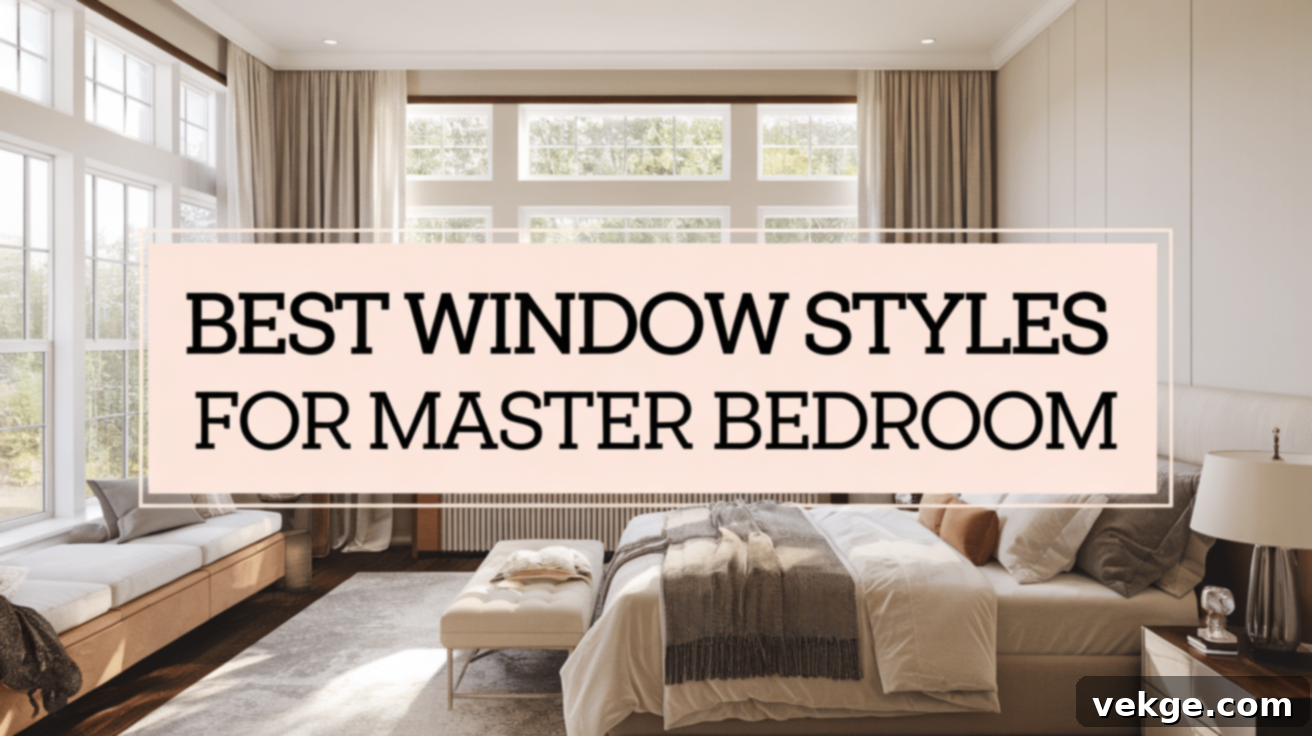Transform Your Master Bedroom: The Ultimate Guide to Choosing the Best Windows
Your master bedroom is more than just a place to sleep; it’s a personal sanctuary for relaxation and rejuvenation. The right windows can profoundly impact this space, influencing everything from its ambiance and comfort to its overall design and energy efficiency. They are not merely openings in a wall but critical design elements that bring in natural light, offer refreshing airflow, and provide essential privacy.
As someone who values both a bright, airy living space and the importance of personal privacy, I understand the delicate balance required when selecting bedroom windows. The ideal window style will seamlessly integrate these needs, creating an environment that feels both open and secure. Some designs prioritize expansive views and maximum light, while others focus on superior ventilation, noise reduction, or a classic aesthetic.
The size, shape, and strategic placement of your windows are also pivotal in shaping the room’s character and functionality. Through my own experiences, I’ve learned that the best windows are those that perfectly align with both comfort requirements and your desired interior design. If you’re considering an upgrade or building a new home, understanding the array of options available is the first step towards making an informed decision.
Whether you’re leaning towards the functional simplicity of sliding windows, the excellent ventilation of casement windows, or the charming aesthetic of bay windows, each style offers distinct advantages. Beyond the frame, material choices and glass types can significantly enhance insulation, reduce energy consumption, and contribute to a quieter, more comfortable bedroom. In this comprehensive guide, we’ll explore various popular window styles and essential considerations to help you select the absolute best windows for your master bedroom, ensuring it becomes the tranquil retreat you deserve.
How the Right Windows Elevate Your Master Bedroom Experience
Windows are far more than just architectural features that let in light. Their impact on your master bedroom extends to various critical aspects, influencing your daily comfort, long-term energy bills, and overall well-being. Thoughtfully chosen windows can dramatically enhance the quality of your personal space in several key ways:
- Maximize Natural Light: A well-lit bedroom feels more spacious, inviting, and uplifting. Optimal windows are designed to draw in abundant sunlight throughout the day, reducing the need for artificial lighting and creating a more vibrant atmosphere. This natural illumination can also positively impact mood and sleep cycles.
- Enhance Airflow and Ventilation: Good ventilation is crucial for a healthy indoor environment. Certain window styles, like double-hung or casement, are engineered to open wide, allowing for excellent cross-ventilation. This brings in fresh air, helps regulate humidity, and prevents stuffiness, making your bedroom a more comfortable place to relax.
- Optimize Temperature Control: The right window glass and frame materials play a vital role in maintaining a consistent and comfortable temperature within your bedroom. High-performance windows can significantly reduce heat gain during summer and heat loss in winter, leading to a more stable indoor climate and decreasing reliance on your heating and cooling systems.
- Ensure Essential Privacy: Your master bedroom should be a private sanctuary. Various window styles and strategic placements, combined with effective coverings, can shield your personal space from outside views while still allowing light to filter in. This balance is key for comfort and peace of mind.
- Reduce Unwanted Noise: If your home is located in a bustling urban area or near a busy street, certain window types and specialized glass options can act as effective sound barriers. These features help to block external noise, ensuring your bedroom remains a quiet haven conducive to rest and relaxation.
- Boost Aesthetic Appeal: Windows are central to your bedroom’s design. Whether you prefer a sleek modern look, a classic traditional feel, or a cozy rustic charm, the chosen window style can complement and enhance your interior décor, adding character and visual interest to the room.
Best Window Styles for a Master Bedroom and Their Unique Benefits
When it comes to selecting windows for your master bedroom, the sheer variety of styles can be overwhelming. Each design offers distinct features and benefits, catering to different needs for light, ventilation, privacy, and aesthetic appeal. Let’s explore some of the most popular and effective window styles for your private sanctuary.
1. Large Picture Windows for Maximum Natural Light and Panoramic Views
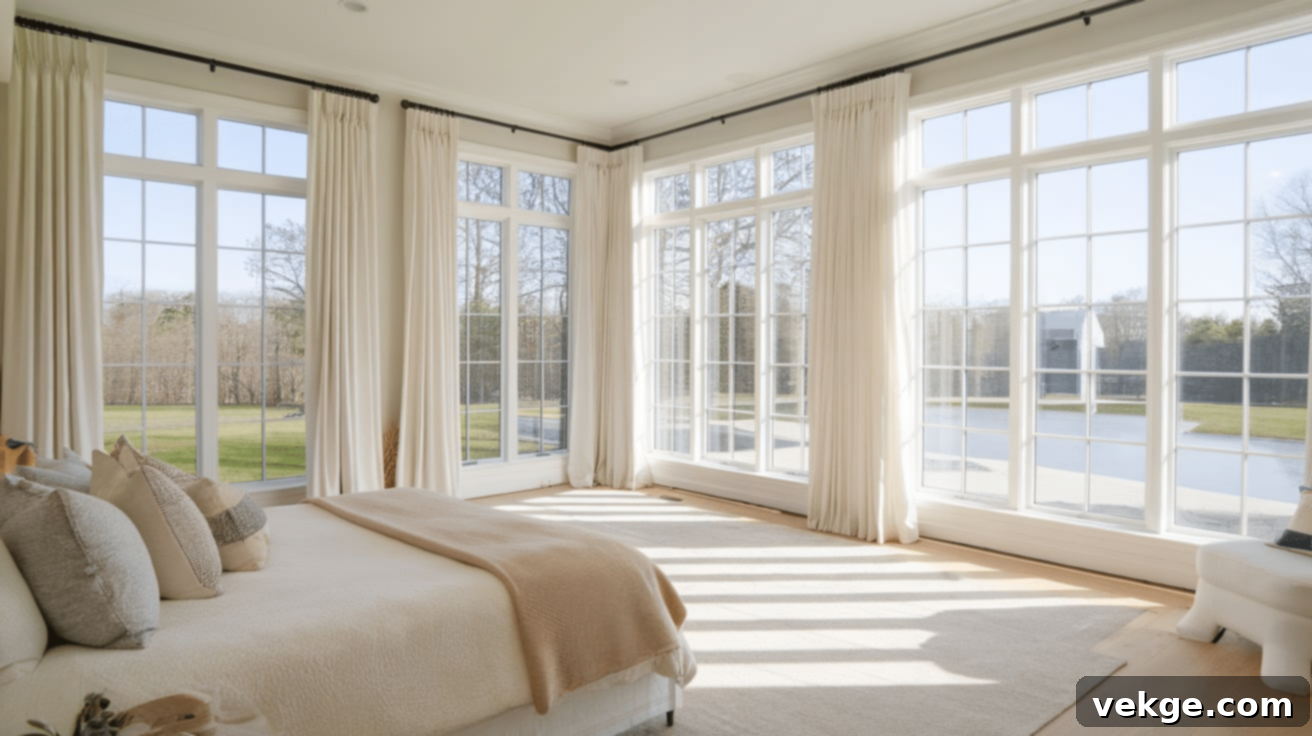
If your master bedroom boasts a stunning outdoor vista or you simply crave an abundance of natural light, picture windows are an exceptional choice. These large, fixed panes of glass do not open, but they are specifically designed to offer unobstructed views and allow the maximum amount of sunlight to flood your space. They create a seamless connection with the outdoors, making your room feel more expansive and integrated with its surroundings. Picture windows are particularly effective in bedrooms with beautiful garden views, oceanfront properties, or serene natural landscapes.
Pros
- Brings in the most natural light, making the room feel significantly brighter and more open.
- Offers unparalleled, unobstructed views of the outdoors, essentially turning your wall into a dynamic piece of art.
- Creates an open, airy, and expansive feel, ideal for making smaller rooms appear larger.
- Highly energy efficient due to their fixed nature, minimizing air leaks when properly installed.
Cons
- Does not open, meaning they offer no natural airflow or ventilation. This can be mitigated by pairing them with operable windows nearby.
- You will need external solutions like curtains, blinds, or specialized glass for privacy, as they provide a clear view both in and out.
- Can lead to heat gain in summer if not paired with Low-E glass or proper shading.
2. Double-Hung Windows for Easy Airflow and Convenient Cleaning
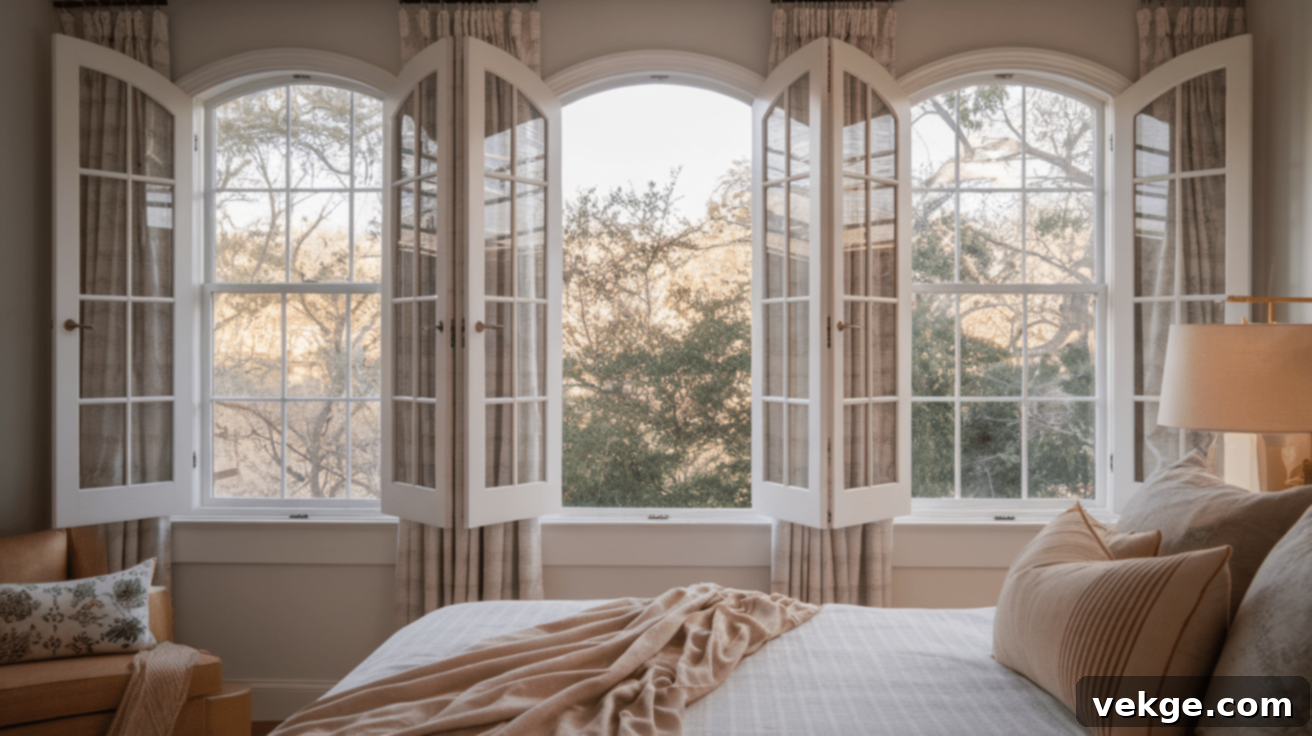
Double-hung windows are a timeless and highly versatile option, characterized by two sashes that slide vertically past each other. This design allows for flexible ventilation, as you can open either the top sash, the bottom sash, or both simultaneously. This feature is excellent for promoting air circulation, drawing cooler air in through the bottom while allowing warmer air to escape through the top. A significant advantage of many modern double-hung windows is their tilt-in feature, which makes cleaning both the interior and exterior surfaces remarkably easy and safe from inside your home, a true convenience for any homeowner.
Pros
- Allows for versatile airflow from both the top and bottom, which is excellent for natural ventilation and temperature regulation.
- Easy to clean both interior and exterior glass surfaces from the inside, thanks to tilt-in sashes.
- A classic and traditional aesthetic that complements most architectural styles and bedroom designs.
- Secure, as both sashes can be locked, and screens can be added for pest control when open.
Cons
- Can be less energy efficient than fixed or casement windows if not properly sealed or maintained due to more moving parts.
- May require regular maintenance (lubrication, track cleaning) to ensure smooth operation of moving parts over time.
- The meeting rail between the two sashes can slightly obstruct the view compared to single-pane windows.
3. Casement Windows for Superior Ventilation and Enhanced Security
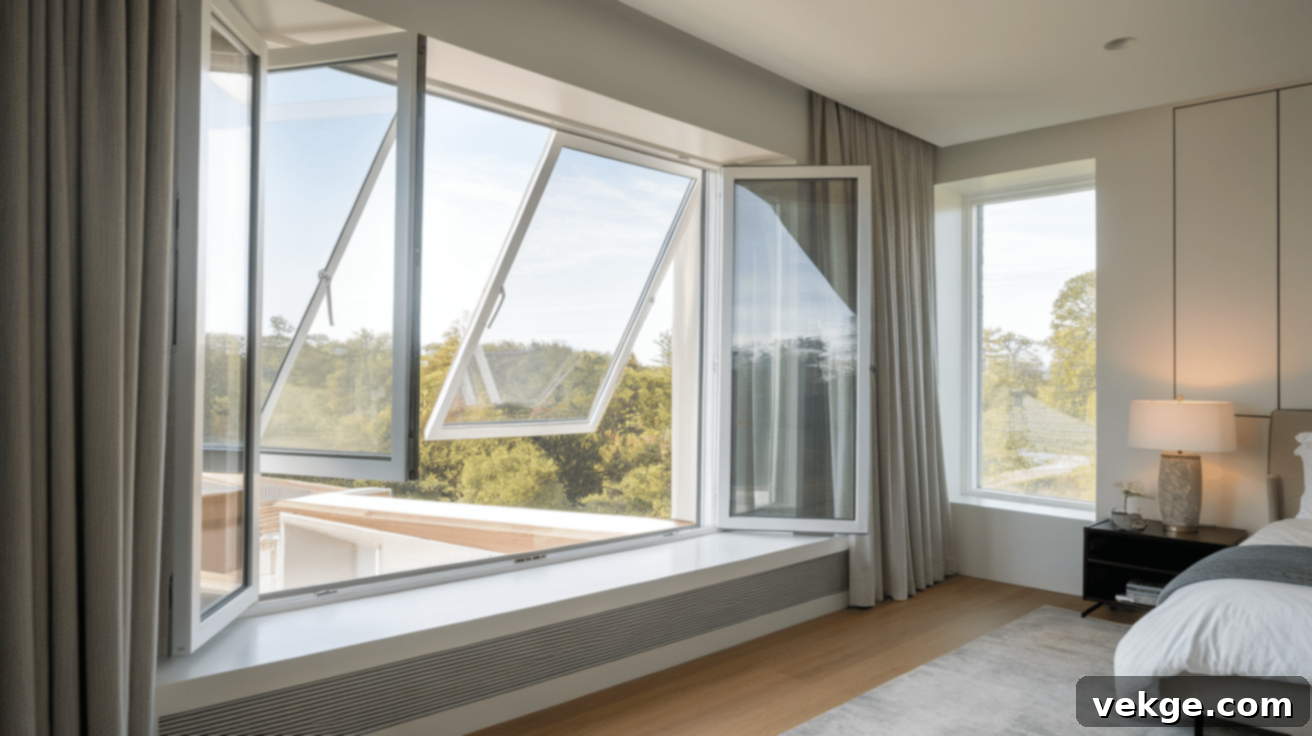
Casement windows are celebrated for their modern appearance and outstanding performance. Operated by a crank mechanism, these windows swing outward, providing an excellent seal when closed and exceptional ventilation when open. Their design allows the entire window pane to open, acting like a funnel to direct breezes into your room. When closed, casement windows press tightly against the frame, creating an incredibly airtight seal, which significantly boosts their energy efficiency. This tight seal also makes them highly secure against intruders.
Pros
- Opens wide (up to a 90-degree angle) for maximum fresh air and superior ventilation, effectively capturing side breezes.
- Seals tightly against the frame when closed, making them one of the most energy-efficient operable window types and preventing drafts.
- Adds a sleek, modern, and uncluttered look to the bedroom with large glass panes.
- Excellent security due to their crank hardware and hook-shaped locks embedded in the frame.
Cons
- Requires clear space outside for the sash to swing open, which might be an issue near walkways or decks.
- Can be harder to operate if placed in a hard-to-reach area, such as over a kitchen sink or a deep bathtub, though this is less common in master bedrooms.
- Screens are installed on the inside, which can sometimes interfere with window coverings.
4. Bay or Bow Windows for Expanded Space and a Grand Stylish Look
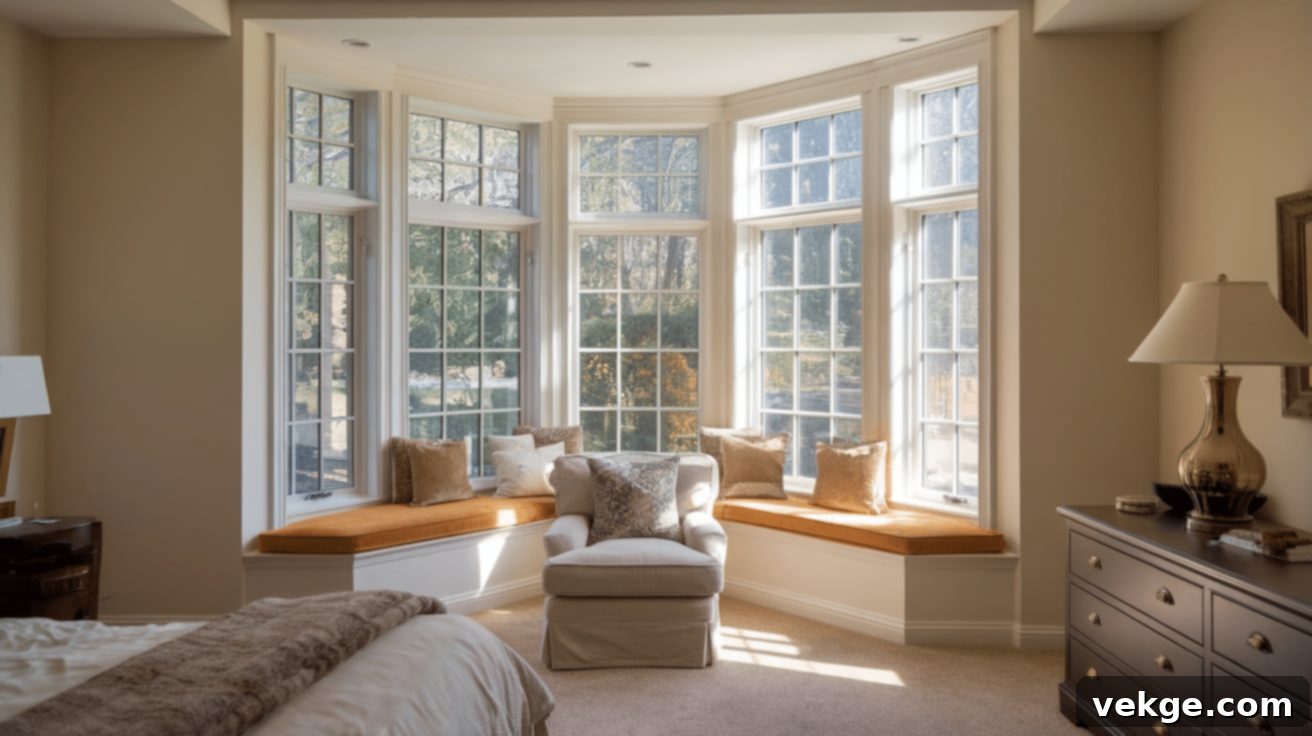
Bay and bow windows are architectural marvels that extend outward from your home’s exterior wall, immediately adding visual interest and creating a charming alcove inside your bedroom. A bay window typically consists of three windows—a large fixed central pane flanked by two smaller operable windows (often casement or double-hung)—projecting at sharp angles. A bow window, on the other hand, features multiple equal-sized windows that form a gentle, graceful curve. Both styles significantly enhance the feeling of space, invite more natural light from multiple directions, and often create a cozy, built-in seating area perfect for reading or enjoying the view. They become a prominent focal point, adding significant character and value to your home.
Pros
- Makes the bedroom feel substantially larger and more open by extending the wall outwards.
- Creates an inviting, cozy sitting or reading nook, adding functional and aesthetic value to the room.
- Lets in significantly more natural light from various angles compared to a flat window.
- Adds a grand, luxurious, and highly stylish architectural statement, boosting curb appeal and property value.
Cons
- Can be more expensive to purchase and install due to their complex structure and custom fitting requirements.
- Requires more exterior wall space and a deeper foundation to support the projection.
- May require specialized window coverings due to their unique shape and angles.
- Potentially less energy efficient if not properly installed and insulated, especially around the joins.
5. Sliding Windows for a Simple, Modern, and Space-Saving Look

Sliding windows, also known as gliders, operate by moving horizontally along a track, rather than vertically or outward. They typically feature two sashes, with one sliding past the other. This simple, intuitive operation makes them a popular choice for contemporary bedroom designs and spaces where outward-swinging windows aren’t practical. Their sleek profile and wide glass panes offer unobstructed views, making them ideal for bedrooms that overlook a garden or have a long, horizontal wall space. They are particularly well-suited for rooms where space is at a premium, as they don’t require any additional clearance for operation.
Pros
- Simple and effortless to open and close, making them very user-friendly.
- Excellent for modern and minimalist bedroom designs, offering a clean, unobstructed view.
- Works exceptionally well in small spaces or areas where an outward-swinging or vertical-opening window would be impractical.
- Provides good ventilation by allowing a large opening for air to flow through.
Cons
- Requires regular cleaning of tracks to prevent dirt and debris buildup, which can impede smooth operation.
- May not seal as tightly as casement windows, potentially leading to slightly less energy efficiency if not high-quality.
- Can be challenging to clean the exterior of the fixed sash if it doesn’t have a tilt-in feature or isn’t easily accessible.
How to Choose the Right Window Size for Your Master Bedroom
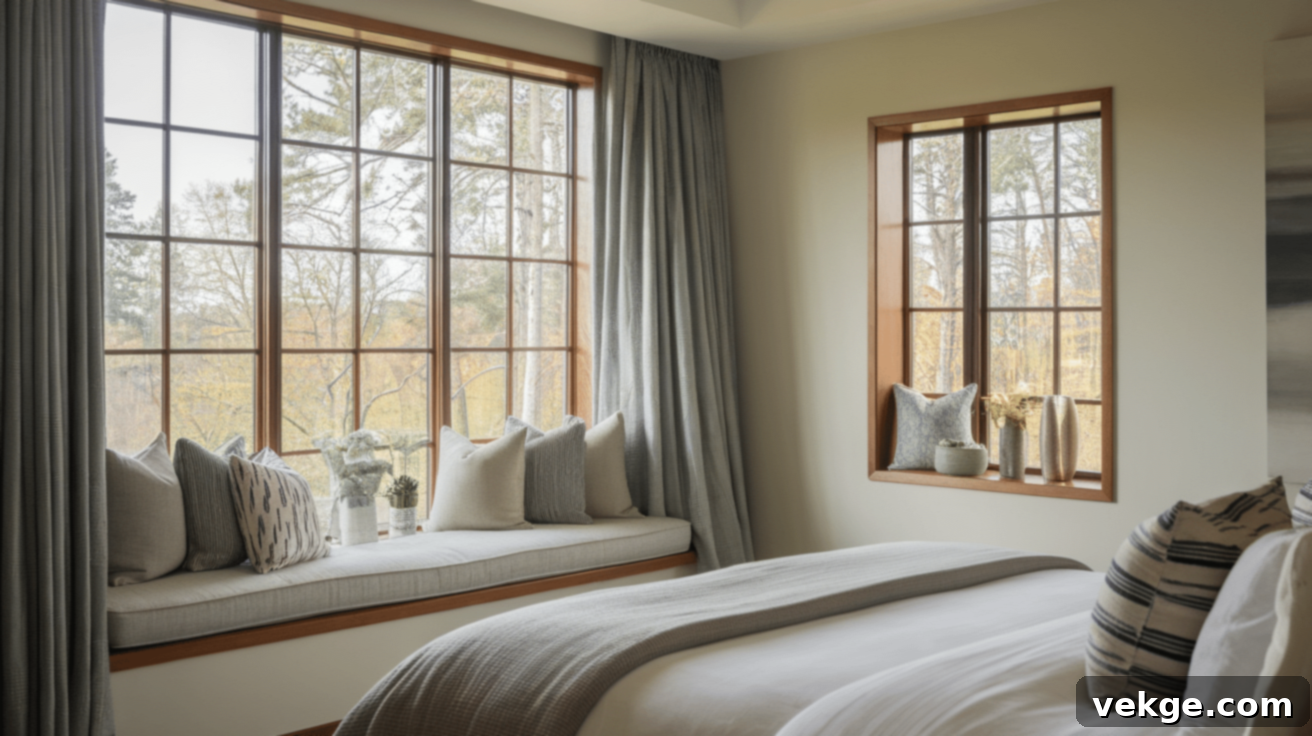
The size and placement of your master bedroom windows are crucial factors that significantly influence the room’s atmosphere, functionality, and overall aesthetic. Thoughtful consideration of these elements can transform a dark, cramped space into a bright, airy sanctuary.
- Larger Windows for Amplified Light: If your bedroom tends to be dark or feels enclosed, opting for larger windows can dramatically brighten the space. More expansive glass panes allow a greater influx of natural light, making the room feel more open, welcoming, and vibrant. They can also create a stronger visual connection to the outdoors.
- Smaller Windows for Enhanced Privacy: For bedrooms where privacy is a top concern, especially those facing busy streets or close neighbors, smaller, strategically placed windows can be ideal. High-placement windows or transom windows, for instance, can let in ample light while maintaining privacy by limiting direct lines of sight into the room.
- Balanced Window Placement: The orientation of your windows impacts both light and airflow. Placing windows on opposite walls facilitates excellent cross-ventilation, ensuring a constant flow of fresh air. Consider the sun’s path: east-facing windows welcome morning light, while west-facing windows bring in warm afternoon sun, and north-facing windows offer consistent, diffused light.
- Consider Wall Space and Furniture Layout: Before committing to large windows, visualize your furniture arrangement. Ensure that windows don’t occupy too much wall space if you plan to place headboards, dressers, or art beneath or beside them. Balance the desire for light with the practical need for wall space for décor and furnishings.
- Architectural Harmony: The size of your windows should also harmonize with the overall architectural style of your home and the scale of the bedroom. Windows that are disproportionately large or small can look out of place.
Best Window Glass Options for Comfort and Energy Savings
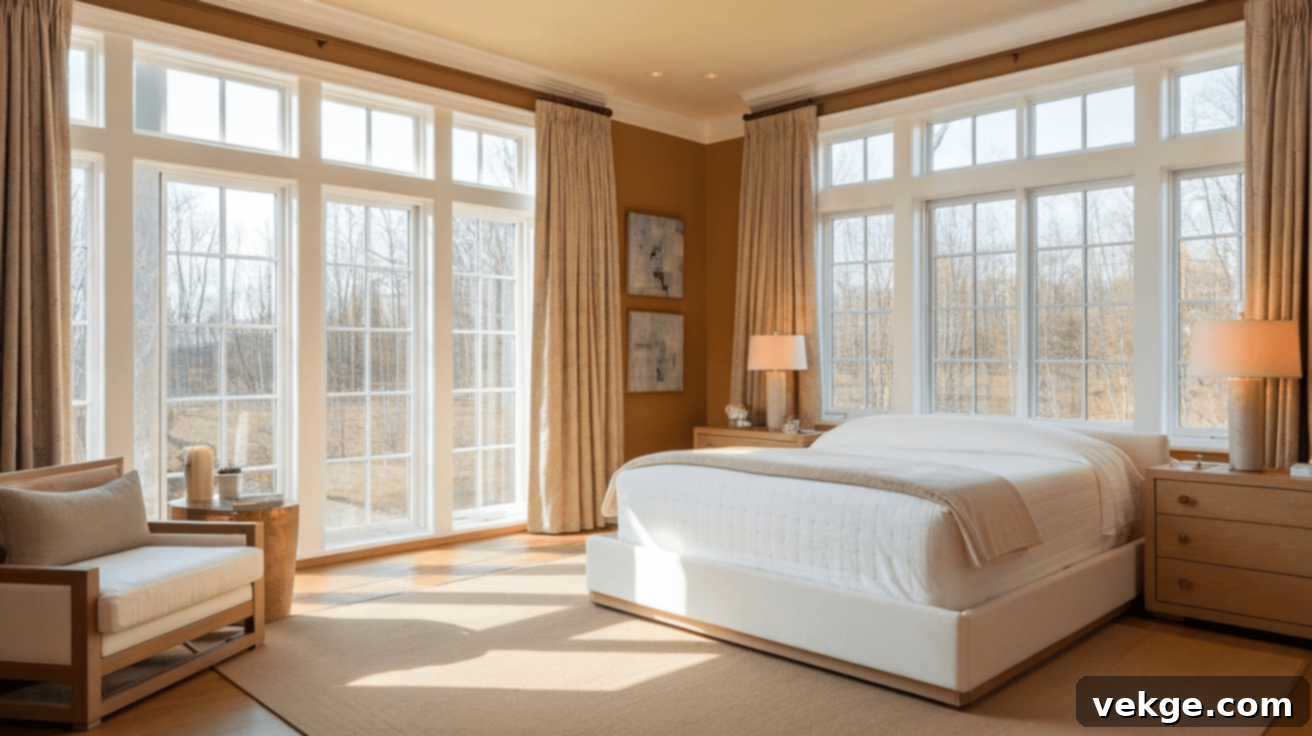
Beyond the frame and style, the type of glass you choose for your master bedroom windows plays a paramount role in energy efficiency, comfort, and even safety. Investing in the right glass technology can lead to significant long-term savings and a noticeably more pleasant living environment.
- Double or Triple-Pane Glass: This is a standard for energy efficiency. Instead of a single pane, these windows feature two or three panes of glass separated by a sealed air or gas-filled space (often argon or krypton). This creates an insulating barrier that significantly reduces heat transfer, helping to keep heat inside during winter and outside during summer, thereby lowering your heating and cooling costs.
- Low-Emissivity (Low-E) Glass: Low-E glass has a microscopically thin, transparent coating that reflects infrared light (heat) while allowing visible light to pass through. This means it helps keep your room cool by reflecting solar heat in warm climates and warm by reflecting internal heat back into the room in cold climates. It also effectively blocks harmful UV rays, protecting your furniture and flooring from fading without significantly darkening the room or blocking natural light.
- Tinted or Frosted Glass: These options are excellent for enhancing privacy without the need for constant coverings. Tinted glass reduces glare and incoming heat, offering a subtle level of privacy. Frosted or obscure glass provides a greater degree of privacy by blurring views, making it ideal for bathrooms or bedrooms where a strong visual barrier is desired, while still allowing light to penetrate.
- Laminated or Tempered Glass: For added safety and sound reduction, consider laminated or tempered glass. Laminated glass consists of two panes bonded together with an interlayer, which holds the glass together if it breaks, much like a car windshield. This also offers superior soundproofing. Tempered glass is heat-treated for strength and shatters into small, blunt pieces when broken, making it safer than standard glass. These are great choices for windows close to the floor or in high-impact areas.
How to Improve Privacy Without Sacrificing Natural Light
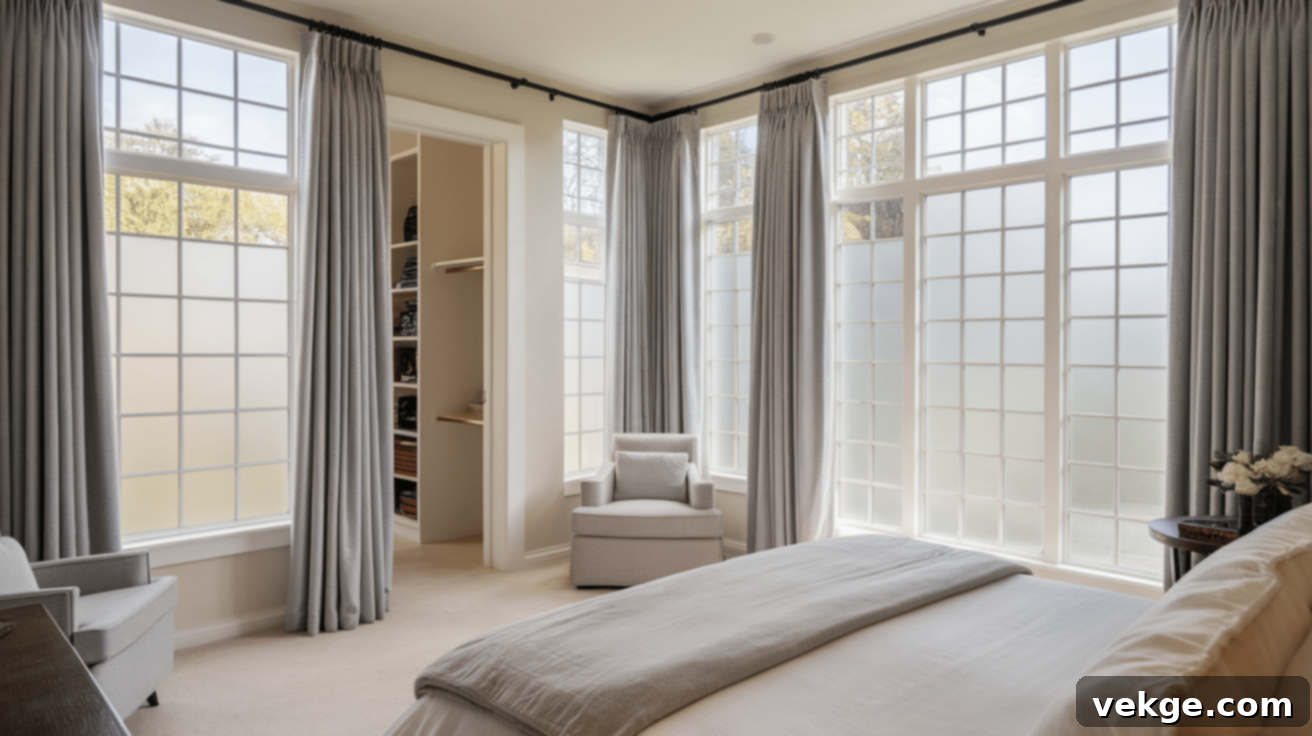
Achieving the perfect balance between abundant natural light and essential privacy is a common challenge in master bedrooms. Fortunately, several innovative and stylish solutions allow you to enjoy brightness without compromising your personal space.
- Utilize Sheer Curtains or Voiles: These lightweight, translucent fabrics allow plenty of natural light to filter into the room while offering a soft veil of privacy during the day. They diffuse harsh sunlight, create a gentle ambiance, and add a touch of elegance without making the room feel enclosed.
- Install Adjustable Blinds or Shades: Options like Venetian blinds, cellular shades, or roller shades provide excellent control over both light and privacy. You can easily adjust the slats or raise/lower the shades to let in as much or as little light as desired, effectively blocking outside views when needed. Top-down/bottom-up shades are particularly versatile, allowing light from above while maintaining privacy below.
- Opt for Frosted or Textured Glass: As discussed, these specialized glass types are designed to obscure views while still permitting light to pass through. Frosted glass provides a uniform opaque look, while textured glass (like obscure or patterned glass) offers decorative patterns that distort visibility. They are a permanent solution for privacy.
- Add Decorative Window Films: A simple, cost-effective, and removable way to enhance privacy is through window films. These adhesive films come in various styles, from frosted and patterned to reflective (one-way mirror effect). They can block views from the outside while still allowing light in, and can be easily applied and removed without damaging the glass.
- Strategic Plantings: For ground-floor bedrooms, planting tall shrubs or trees outside your window can create a natural privacy screen without blocking light from higher up.
Best Window Coverings for Style and Function in Your Master Bedroom
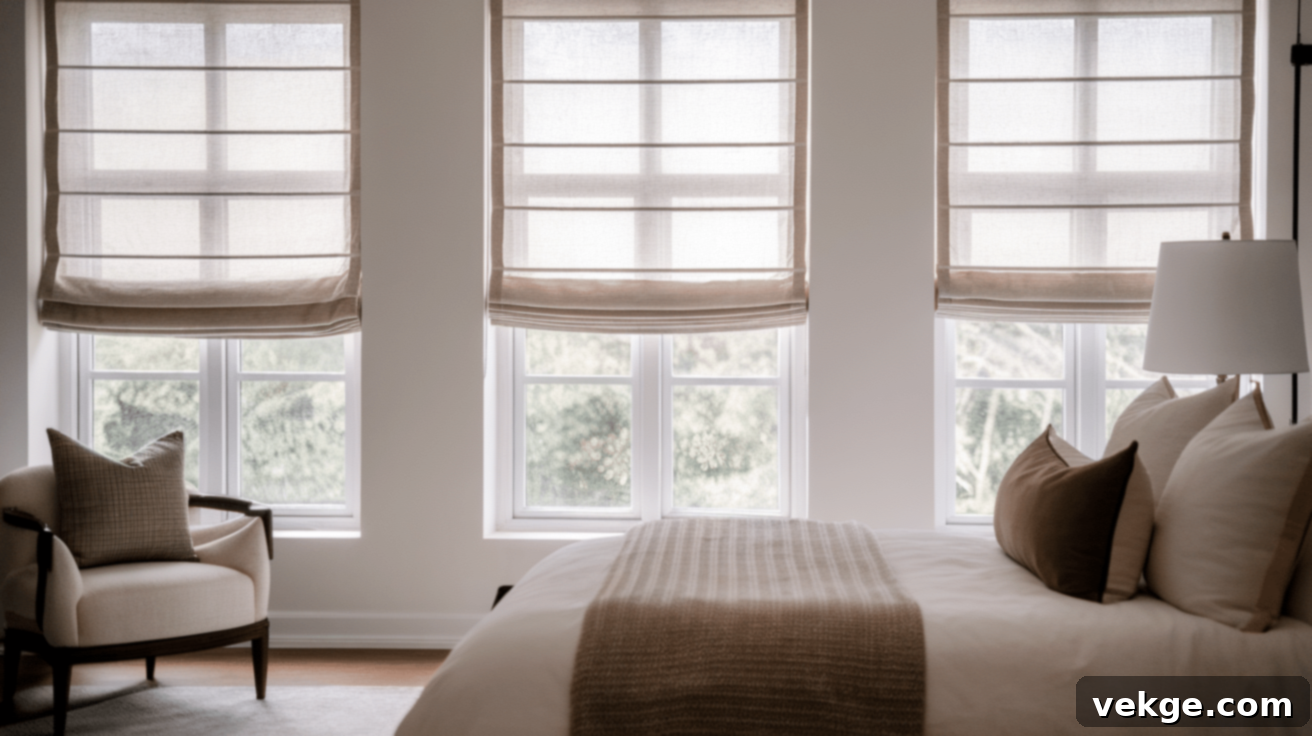
Window coverings are essential not only for managing light and ensuring privacy but also for significantly enhancing the style and comfort of your master bedroom. The right choice can complete your room’s aesthetic while offering practical benefits.
- Blackout Curtains: For those who cherish deep, undisturbed sleep, blackout curtains are a must-have. Made from thick, opaque fabric, they completely block out external light, making them perfect for shift workers, light sleepers, or anyone who enjoys sleeping in late. They also offer excellent insulation and noise reduction.
- Roman Shades: Combining the soft elegance of fabric curtains with the crisp lines of blinds, Roman shades offer a sophisticated look. They fold up neatly into soft pleats when raised and lie flat when lowered, providing adjustable light control and a polished finish. They come in a vast array of fabrics, patterns, and opacities.
- Cellular Shades (Honeycomb Shades): These shades are renowned for their exceptional insulating properties. Their unique honeycomb construction traps air, creating an effective barrier against heat transfer. This helps keep your bedroom warm in winter and cool in summer, contributing to energy savings while offering adjustable light and privacy.
- Wood or Faux Wood Blinds: A classic and timeless choice, wood or faux wood blinds add warmth, texture, and a natural element to your bedroom. They offer excellent control over light and privacy through adjustable slats and are durable and easy to maintain. Faux wood is particularly resistant to humidity, making it a versatile option.
- Layered Coverings: For ultimate flexibility, consider layering. Combine sheer curtains for daytime privacy and diffused light with blackout curtains or blinds for nighttime darkness and insulation. This allows you to easily switch between different levels of light, privacy, and insulation as needed.
Energy-Efficient Windows: Smart Choices to Save on Bills
Upgrading to energy-efficient windows in your master bedroom is one of the most effective ways to reduce your utility bills and enhance year-round comfort. Modern window technology focuses on minimizing heat transfer, ensuring your heating and cooling systems work less strenuously.
- Windows with Low-E Coatings: As previously mentioned, Low-E glass is critical for energy efficiency. It reflects radiant heat, meaning your indoor temperatures remain more stable regardless of the outside weather. This significantly reduces the workload on your HVAC system.
- Double or Triple-Pane Glass with Inert Gas Fills: The insulation provided by multiple panes of glass is further boosted by filling the space between them with inert gases like argon or krypton. These gases are denser than air and provide superior thermal performance, further minimizing heat transfer.
- Proper Sealing and Weatherstripping: Even the most advanced windows will underperform if not properly sealed. Ensure that the window frames are tightly sealed during installation and that weatherstripping around operable parts is intact. This prevents air leaks and drafts that can lead to significant energy loss.
- Insulated Frames: The frame material itself contributes to a window’s overall energy efficiency. Materials like vinyl and fiberglass offer excellent insulation properties, as they do not conduct heat as readily as aluminum. Look for frames that are specifically designed with thermal breaks to prevent heat transfer through the material.
- NFRC Ratings: When shopping, look for windows with a National Fenestration Rating Council (NFRC) label. This label provides objective performance ratings for U-factor (insulation value) and Solar Heat Gain Coefficient (SHGC – how much solar radiation passes through). Lower U-factor and appropriate SHGC values indicate better energy performance for your climate.
How to Clean and Maintain Bedroom Windows for Long-Lasting Use
Regular cleaning and maintenance are key to ensuring your master bedroom windows not only look their best but also function efficiently and last for many years. A little consistent effort can prevent major issues and preserve their aesthetic appeal and energy performance.
Here are some simple tips for keeping your windows in top condition:
- Clean Glass Regularly: For streak-free windows, a simple mixture of warm water and white vinegar (50/50 ratio) works wonders. Use a microfiber cloth or squeegee for the best results. For tougher grime, a drop of dish soap can be added. Regular cleaning prevents mineral buildup and maintains crystal-clear views.
- Wipe Down Frames and Tracks: Dust, dirt, and debris can accumulate in window frames and tracks, especially in sliding windows. Use a damp cloth or a small brush (like an old toothbrush) to regularly clean these areas. Keeping tracks clear ensures smooth operation and prevents wear on moving parts.
- Check for Air Leaks and Damaged Seals: Periodically inspect weatherstripping, caulk, and seals around your window frames. Over time, these can crack, shrink, or become brittle, leading to air leaks and reduced energy efficiency. Replace worn-out seals or reapply caulk as needed to maintain a tight, energy-efficient barrier.
- Lubricate Moving Parts: For casement windows with cranks and sliding windows, apply a silicone-based lubricant to the moving mechanisms (hinges, tracks, and locks) once or twice a year. This keeps them operating smoothly, prevents sticking, and extends their lifespan.
- Inspect for Drainage Issues: Ensure that weep holes (small openings at the bottom of the window frame) are clear of debris. These holes are designed to drain water that enters the frame, preventing it from pooling and causing damage.
Conclusion
Choosing the right windows for your master bedroom is a decision that extends beyond mere aesthetics. It’s about creating a space that is more comfortable, more private, more stylish, and significantly more energy-efficient. From the moment you wake up to the peaceful close of your day, the windows in your sanctuary play a pivotal role in shaping your experience.
We’ve explored a variety of excellent options, each bringing its unique set of benefits. Picture windows offer breathtaking, unobstructed views and an abundance of light, perfect for scenic locations. Double-hung windows provide versatile ventilation and easy maintenance. Casement windows excel in superior airflow and exceptional energy efficiency, while bay and bow windows expand your space and add a touch of grand architectural elegance. For modern designs and space-saving solutions, sliding windows offer simplicity and wide views.
Beyond style, thoughtful considerations regarding window size, advanced glass options like Low-E or multi-pane, and the overall energy efficiency of the unit are crucial. These choices directly impact your comfort, your privacy, and your long-term utility bills. Moreover, never underestimate the power of window coverings—from sheer curtains to blackout shades—in providing the perfect balance of light control, insulation, and personal privacy.
By carefully evaluating your needs, exploring different styles, and understanding the technological advancements in window design, you can make an informed decision that truly transforms your master bedroom. Invest the time to select windows that not only complement your home’s architecture but also enhance your daily living. The right windows will indeed turn your bedroom into a more enjoyable, serene, and inviting retreat where you can truly relax and unwind, year after year.
Frequently Asked Questions About Master Bedroom Windows
How Do I Choose the Right Window Size for My Bedroom?
The ideal window size depends on your specific needs and the room’s characteristics. Larger windows maximize natural light and can make a room feel more spacious, especially if you have an appealing view. Smaller, strategically placed windows (like those higher on a wall) offer more privacy while still allowing light. Consider your wall space, how much natural light you desire, the need for privacy, and your planned furniture layout to determine the best size.
How Can I Improve Privacy in My Bedroom with Windows Without Blocking All Light?
There are several effective ways to achieve privacy without sacrificing natural light. You can use sheer curtains or translucent window films to diffuse views while letting light in. Adjustable blinds or top-down/bottom-up shades offer flexible control over light and privacy. Frosted or textured glass provides a permanent privacy solution, blurring outside views while allowing light to filter through.
What Type of Window Is Best for a Small Master Bedroom?
For a small master bedroom, sliding windows are an excellent choice because they operate horizontally and don’t require any outward or upward space to open, making them ideal for tight areas. Smaller picture windows can also work well, offering a sleek, minimalist look that still allows light to enter without consuming valuable wall space needed for furniture.
How Do I Keep My Windows Clean and Well-Maintained?
To keep your windows looking good and functioning properly, regularly clean the glass with a mixture of water and vinegar for a streak-free shine. Wipe down frames and clean the tracks to prevent dirt buildup that can impede operation. Periodically check for air leaks and ensure seals are intact, replacing any worn-out weatherstripping. Lubricate moving parts of casement or sliding windows to ensure smooth operation.
Can I Make My Bedroom More Energy-Efficient with New Windows?
Absolutely! Upgrading to new, energy-efficient windows can significantly reduce your heating and cooling costs. Look for windows with double or triple panes of glass, especially those filled with inert gases like argon. Low-E coatings on the glass are also crucial as they reflect heat. Additionally, choose windows with insulated frames (like vinyl or fiberglass) and ensure proper sealing and installation to prevent drafts and maximize thermal performance.
